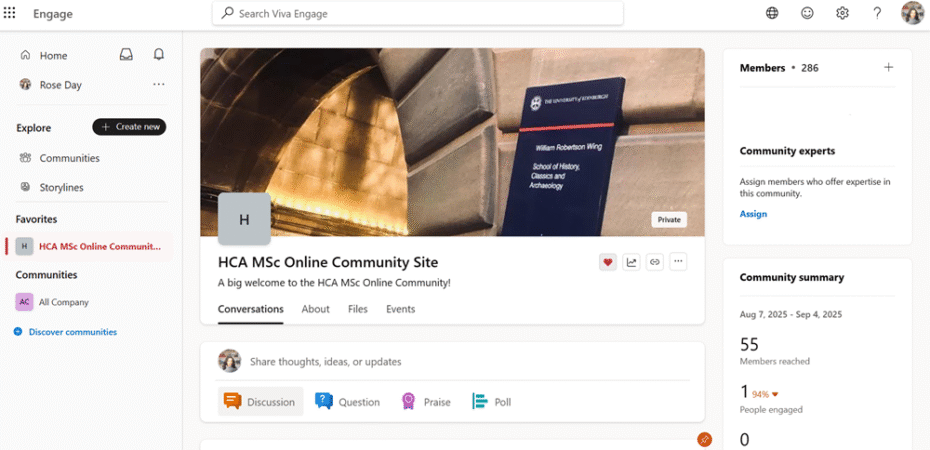
In this extra post, Rose Day asks the question, how do we foster a sense of community and connection among online students, especially those who may never meet face to face? This is the challenge she has been exploring in the School of History, Classics and Archaeology (HCA), where they recently reimagined their approach to building online belonging by launching a new Community Site for Online MSc students on Viva Engage. Rose shares their story and reflects on some lessons learned. Rose is a Learning Technologist in HCA.
From Learn Ultra to Viva Engage
Originally, we hosted an online community space on Learn Ultra, structured as a module for all HCA online postgraduate students. While the intention was sound—to create a shared space for announcements, questions, and conversation—the reality was that it struggled to gain traction. Notifications became buried under the weight of course content, and the space felt more like an extension of the VLE than a true social hub. Students rarely interacted with it.
We needed something different; something that felt less like coursework and more like connection.
A shift in approach: Led by learning technology
The move to Viva Engage was initiated by the Learning Technology team within HCA, who recognised that the existing structure wasn’t meeting students’ needs for informal, social connection. Drawing on insights from staff and student feedback—as well as research into online learning communities—we proposed a more flexible, socially driven platform.
Viva Engage (formerly Yammer), part of Microsoft 365, offered a social-media-style interface better suited to student-led discussion. It allowed us to create a dedicated, cross-programme space that felt separate from academic content but still part of the university ecosystem.
Our aim was simple but ambitious: to build a student-centred space that fostered informal introductions, peer support, and shared experience. Crucially, we wanted to avoid the impression of surveillance—students needed to feel it was their space, not just another channel through which staff communicated top-down.

Launching the site: A collaborative effort
While the concept and build of the site were led by Learning Technologists, its success depended on collaboration across multiple roles. My colleagues in HCA IT managed enrollments to ensure all online MSc students were included automatically. Programme Administrators responded to student questions and signposted support. Programme Directors added the human touch, posting at key points in the term to prompt introductions and discussion, helping students feel welcomed and encouraged to participate.
These structured, staff-initiated posts acted as vital touch points, giving students a reason and a moment to engage. One particularly popular thread emerged when dissertation students began sharing their early topic ideas and challenges. This sparked genuine conversation and created a sense of shared experience, even across different programmes.
To support early engagement, we also provided a short, friendly guide to netiquette, reinforcing the importance of respectful and inclusive interaction. Setting expectations early helped establish a tone that was both safe and social, and we explicitly encouraged students to start their own threads—not just respond to staff-led ones. Over time, students began posting questions, sharing resources, and offering support to one another, in a way that felt authentic and peer-driven.
While many students eventually took their conversations into informal channels, like WhatsApp, the initial structured introductions on Viva Engage served as a springboard. The platform acted as a kind of digital threshold space—to borrow Garrison and Vaughan’s (2008) terminology—where a “social presence” could be established before deeper peer interactions migrated elsewhere.
Lessons learned: Community building is slow but worthwhile
Uptake has been gradual—no surprise, perhaps, given the competing demands on students’ time and attention. But compared to our previous Learn Ultra space, engagement on Viva Engage feels more socially driven and sustainable. The format is more intuitive, and the tone more casual.
A few key lessons have emerged:
- Student-centred design matters: Our decision to let students lead the conversation—while staff stepped back—helped avoid the feeling of being “watched.”
- Structured prompts are valuable: Programme Directors’ posts provided gentle scaffolding for interaction at key moments.
- Clear etiquette helps: Offering simple guidance on how to participate gave students more confidence to engage.
- Not all interaction stays in-platform—and that’s okay: The value of the site lies in sparking connections, even if they move elsewhere.
- Tools influence tone: Viva Engage feels more like a digital common room than a noticeboard.
What’s next?
We’re continuing to monitor and adapt the site as it grows. Looking ahead, we’re focusing on improving how we induct online students into the community, making it a more visible and intentional part of their early experience. We’re also exploring how to involve student representatives more actively in shaping and supporting the space, giving it a stronger peer-led dimension.
While we’re still in the early stages, this shift has already helped us better support online students across HCA, especially those who may otherwise feel isolated in their learning. The community may be virtual, but the connections are real.
References
Garrison, D. R., & Vaughan, N. D. (2008). Blended Learning in Higher Education: Framework, Principles, and Guidelines. Jossey-Bass.
Rose Day is a Learning Technologist in HCA, provides advice, guidance and support for a number of technology-enhanced learning initiatives. Rose works with staff to support and develop the use of these learning technologies in teaching, learning, assessment and research. Rose’s activities include advocating the use of learning technologies and helping staff with the design, development and evaluation of learning resources. This is achieved through a programme of courses, workshops and events, providing occasional informal 1:1 support, and creating and delivering online support materials.


